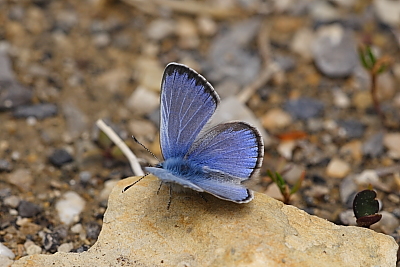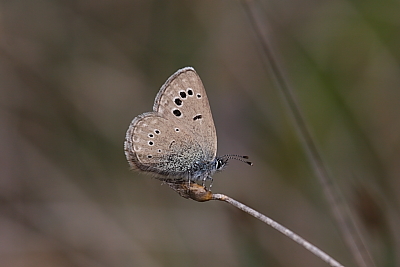







28757_male_Var_19Apr12



Black-eyed Blue (Glaucopsyche melanops)
2024 photographs highlighted in yellow. Click on any photograph to go to an enlarged picture, or simply scroll down the page.
|
Melanops is a very early season species, emerging in early April and largely disappeared by the end of the month. Before 2009, I had seen melanops only a few times, although in subsequent years it has turned up at a number of localities. It is allegedly quite common, although I would not entirely agree with that, certainly compared to the ubiquitous Green-underside Blue (G. alexis). |
Melanops is quite similar to alexis, the principal differences discussed on the alexis page. The female melanops underside can be rather browner than alexis, and with a rather scruffy appearance. |
| ref | sex |
observations |
alt. m |
| 32479 | M | a male, the upperside of 32472. The date is unusually late for the PACA region, especially as this specimen is very fresh, 2013 being a very late year. | 1080 |
| 24440 | M | a fresh male, showing the strong, clean, pale blue characteristic of melanops, and the strong black borders. | 700 |
| 23993 | F | having seen a number of female melanops in 2011, this appears to be fairly typical in terms of the degree of blue scaling. | 140 |
| 14821 | F |
an average amount of blue scaling. |
220 |
| 37109 | F | another female, fairly typical of the Var populations. 37095 is the underside. | 220 |
| 32472 | M | a male, the underside of 32479. | 1080 |
| 14495 | M |
I am assuming this is a male, although the darker, greener ground colour strongly suggests female. |
140 |
| 28757 | M | most probably a male, as blue can be seen at the anal angle, but this is by no means certain. However, on studying the magnified image, the end of the foreleg appears to be hooked, which confirms that this is a male. | 30 |
| 14513 | PAIR |
a mating pair, the greener female above. The marginal marks, especially of the male, are quite pronounced. |
140 |
| 14514 | F |
the female of the above pair, after parting naturally. |
140 |
| 4911 | F |
this female with a distended unf black spot in s2 was only the second I had ever seen, but was considerably larger than the first, and larger than indicated in the books. The marginal marks clearly indicate melanops. |
430 |
| 37095 | F | a rather darkish grey underside ground colour, with rather ghosted marginal markings. This is the underside of 37109. | 220 |
32479_male_Alpes-Maritimes_1Jun13
32472_male_Alpes-Maritimes_1Jun13